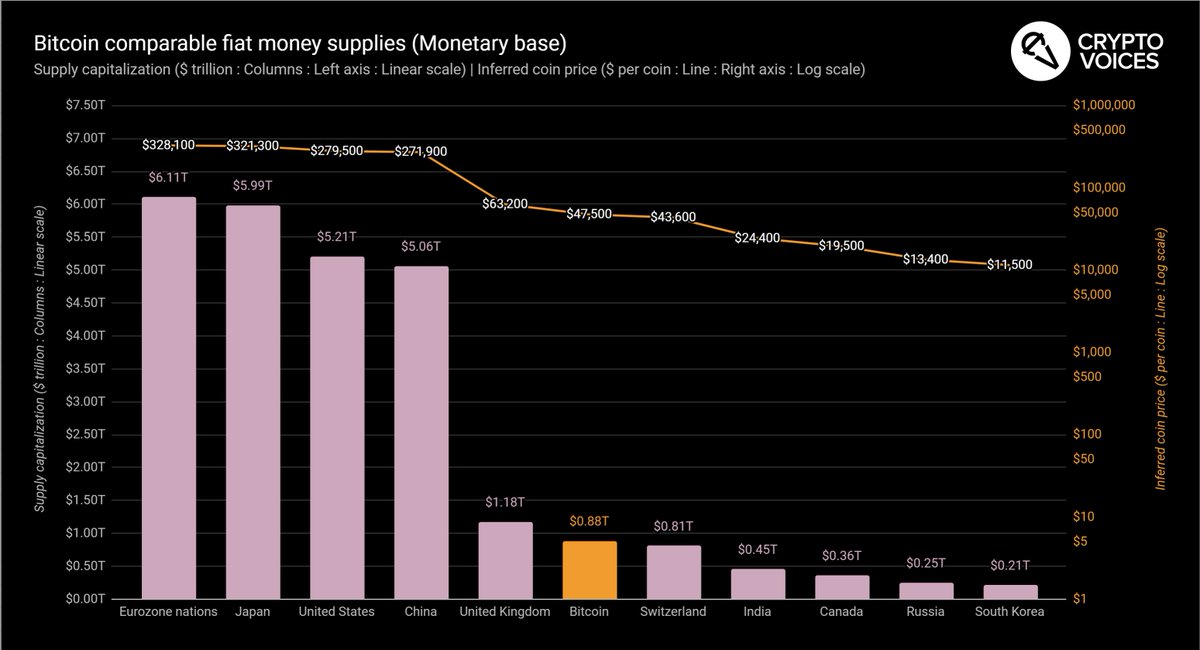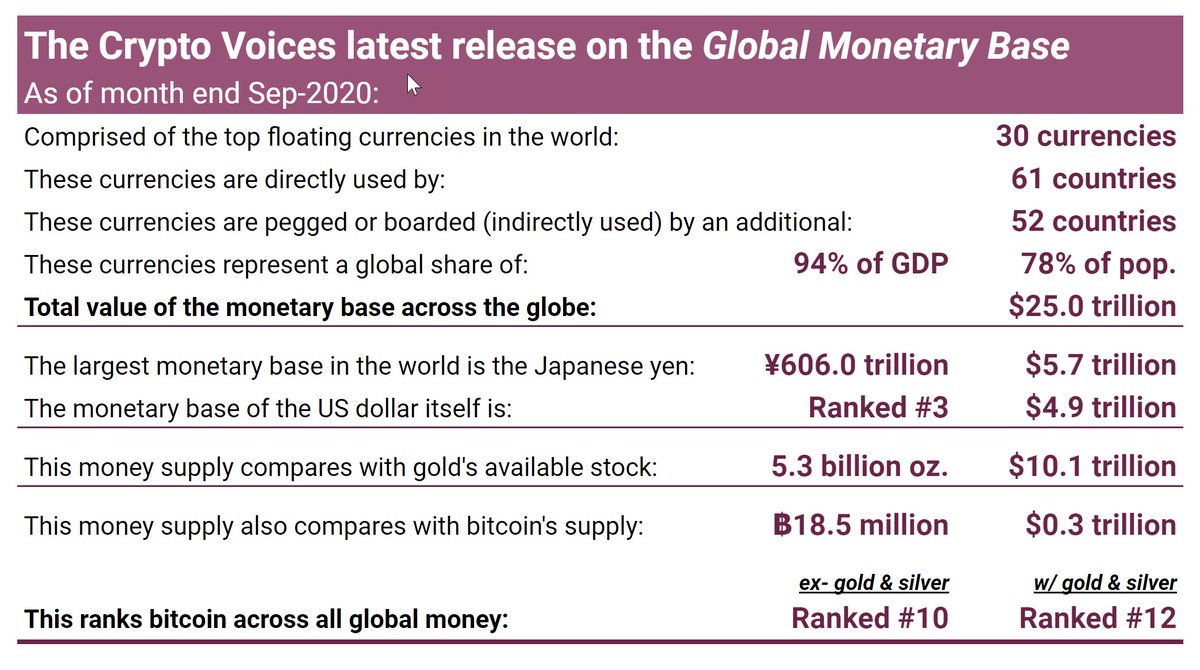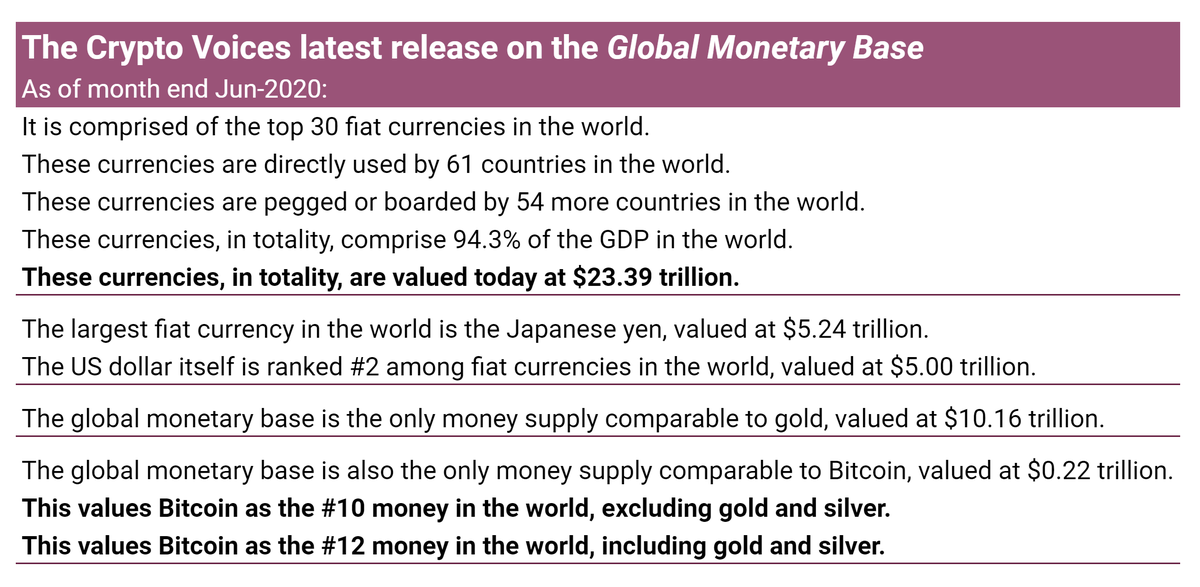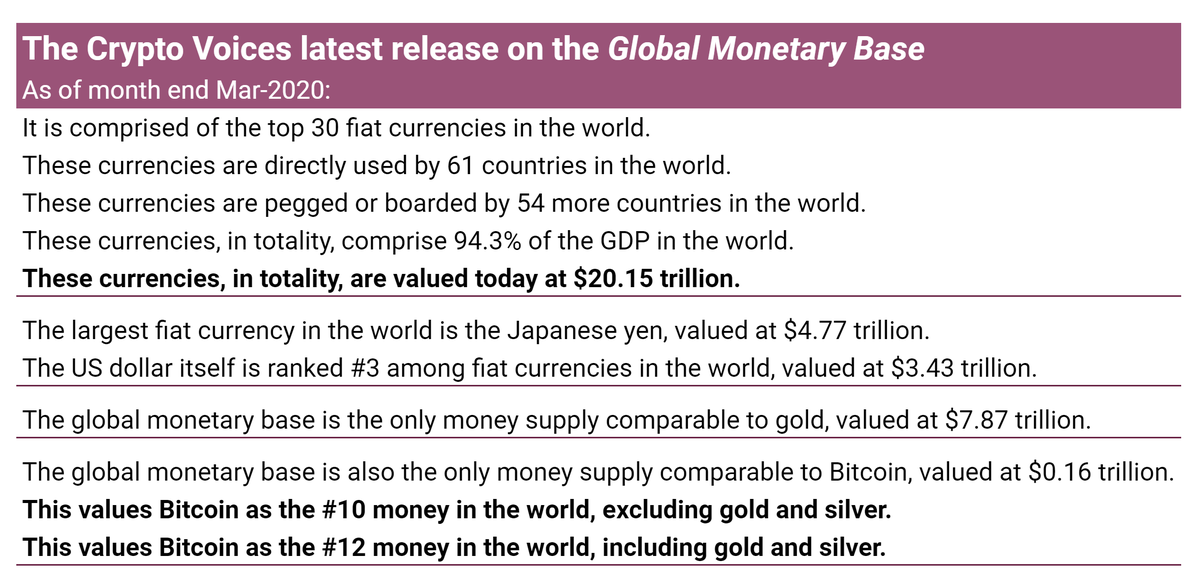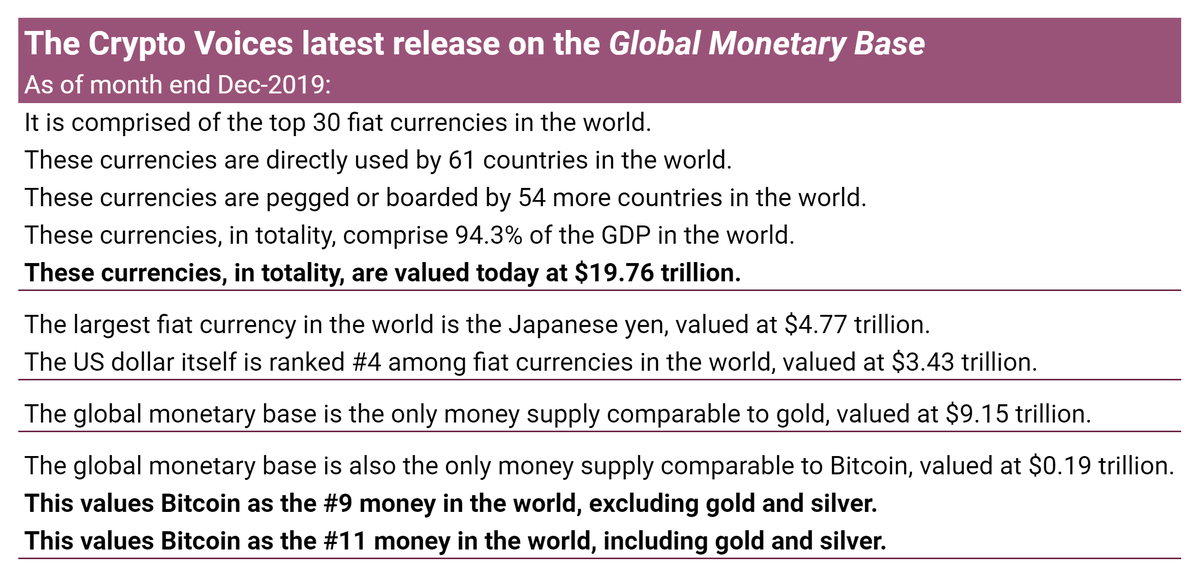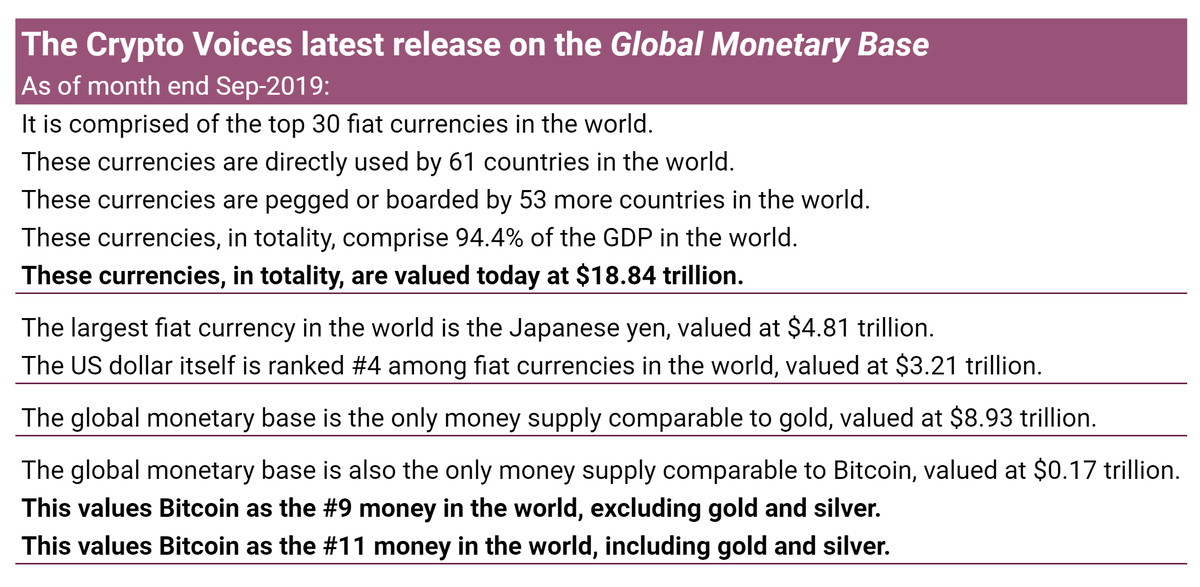
Q1 update on global monetary base. Only money supply that compares with 21 million #bitcoin. Bitcoin remains the 6th largest currency in the world. 7th if you include gold. This is quarterly update #12. 

2/ For 12 years the world's been trying to understand #Bitcoin, forget Bitcoin, criticize Bitcoin, love Bitcoin, hate Bitcoin. Reminder Bitcoin still is a protocol, it does what it does. But if you want to speak of its value as money, you gotta understand the monetary base.
3/ What follows isn't a lesson in stimulus or bailouts, whatever the world faces. It's an attempt at painting the monetary landscape around the globe. This is an exercise in perspective. The dollars, euros, and yen we're all familiar with, collectively, are worth $27.8 trillion.
4/ As many know, the response from governments worldwide to Covid-19 has been drastic, so expect big moves.
5/ Gold & silver is base money of the past. Government fiat is base money today. It comprises both physical cash, *and* a digital cash component. Bitcoin may be base money of the future. Before we show the charts, it's important to clarify exactly what basic money is.
6/ The first thing is everyone looking to value Bitcoin always jumps to the "narrow" or "broad" money supplies (M1/M2/M3). This is incorrect. The reason is those money supplies represent "claims" on something else. What is that something else? Answer: the base money supply.
7/ Fiat base money today includes both physical (notes & coins) and digital (bank reserves at the central bank) components. Think of the digital part as the "account" each bank holds with its central bank. This & only this money supply compares economically with 21 million BTC.
8/ Why? Because that is the end of the line. It's *final*…settlement, in either system. There's no deeper level you can go to in the financial monetary system than the monetary base, and there's no deeper level you can go to in the Bitcoin system than on-chain bitcoins.
9/ Another mistake that's often made when comparing bitcoins to the analog monetary world is looking at a simple chart like US M1, or Eurozone M2. Besides again being incorrect on the M1/M2/M3 comparison, this method is inadequate because Bitcoin is global, and those... are not.
10/ We can't simply look at one or two nation states' base money supplies to gauge any kind of market depth. The sample must be global. We've done that here, tracking the top 30 floating currencies in the world. This is how the real global fiat base money supply looks since 1970. 

11/ This top 30 base money sample in fact covers 95% of global GDP, 113 countries, and 64 currencies. Why? The euro is one reason. The other is these countries/currencies either use one of these floating top 30 directly, or are legally pegged or fixed to one via currency board.
12/ More on the above image. It is essentially ordered by GDP per currency bloc; the one exception is the UK's pound sterling. It's monetary base is larger than India's, which is further down the list.
13/ Let's look again at the global base money supply curve since 1970, but this time see how the split shakes out between physical versus digital base money. Note how bank reserves (the digital printing press) drastically increased its overall % from the 2008 financial slide. 

14/ Final point on fiat money. The monetary base is in fact a graph of the money monopoly today; meaning, it is the source of the printing press, and only central banks control this. If you're curious where to find it, the answer is simple: the balance sheet of each central bank.
15/ Now let's look at gold. Central banks still hold gold, but it no longer acts as basic money. A few points coming on this, but everyone should still understand the global gold supply in both its native market unit (ounces), and in today's unit of account (US dollars). 

16/ Still on gold, here's a chart you don't see everyday. It's central bank gold holdings vs. their monetary bases. For those that still view gold as a market money, then any fiat money central banks can print above their gold holdings is - by definition - seigniorage. 

17/ True, many emerging market central banks are net buyers of gold these days. But actually central banks hold less gold collectively than in 1965. Notice how high the proportion of gold reserves-to-issued base money was in 1980 (both valued in US$). Today, it's only 6%.
18/ In other words, central banks collectively have issued $25 trillion in base money *above* the value of their gold holdings (again, both marked to market in USD). This is an important fact that has implications for central bank money printing, for gold, and for bitcoin.
19/ What is that implication? So far, the money monopoly "works" for central banks, and for their governments. It's virtually costless: fiat has proven to be nearly "unconstrained" by the market value of gold. Some claim CBs manipulate the gold price; we won't address that here.
20/ As for #bitcoin, if and when it becomes large enough to be on that chart, and held by central banks, only then will know what bitcoin "costs" central banks. For now, bitcoin "costs" central banks nothing in seigniorage; it's a rounding error. But it's growing. Quickly.
21/ Now silver. 54 billion ounces of the stuff has been mined throughout humanity. Note, we include 3 categories for both gold & silver: "all-time" mine production, "available" estimates (i.e. not lost to industry), and "monetary" estimates (bullion). Since 1970, this is silver. 

22/ And finally Bitcoin. Bitcoins are limited by the protocol to an eventual 21 million in supply by 2141, and each day it seems more likely that bitcoins could circulate as base money of the future: a deep & balanced final settlement money supply. Here's its global supply curve. 

23/ And now we'll put them altogether - global fiat, "available" gold, "available" silver, and bitcoin - today. Without further commentary, note that the Bitcoin system is the 6th largest money in the world, and the 7th largest money if gold included. 

24/ And for a broad, historical ranking in table format, a progression of all major money for the entirety of #Bitcoin's history since 2009, that information is here. 

25/ And for those that wish to see that progression against the remaining fiat currencies, and how quickly (if) #Bitcoin passed each one, that chart is here. Note that this year #Bitcoin passed the Swiss franc in value for the first time ever. 

26/ Now for the main event of this analysis: Inflation. Inflation today means "price increases." It's usually measured by the central bank and usually wrong. There is no way all prices can ever be measured in a simple index. The input variables are changed all the time to boot.
27/ When we analyze inflation, we are using the classical definition, which is "monetary inflation." In other words, "money growth," or "money production." Understanding this rate of increase can be very helpful when trying to understand money.
28/ Inflation is one of the most important things to understand about money, in fact. Money growth inflation reflects scarcity, and dilution, relative to other goods. But to be clear... 🤌 The charts that follow have nothing to do with price growth, or prices, at all. 🤌
29/ Let's jump to it. This is the last 12 months of all base money growth. Remember, this is "unit" growth. % changes in dollars, euros, or yen, ounces of gold, or bitcoins. Big… big... numbers. 

30/ But we need to look deeper. It helps to look long-term. Remember the global fiat supply curve? In 1970, the US$ equivalent of global base money was $200 billion. Today: $27.8 trillion. What does this mean? To understand it, you need to understand compound annual growth.
31/ Compound annual growth is an extremely important metric. It's "stronger" than a simple, annual rate (cryptovoices.com/compound-retur…). We can use this rate to understand investment returns, or long-term trends like population growth. We can also derive doubling time from this figure.
32/ So let's start with the compound annual growth rates for the global monetary base since 1970. 50 years of data. About half the countries' data goes back this far. For the rest, % displayed is since their start date. For bitcoin, the start date is Jan-2009. 

33/ Doubling time also helps. From compound growth %, we can determine exactly how long it takes for an asset's supply to double. Here is the exact same chart as just shown, since 1970 (and since 2009 in Bitcoin's case), but displaying doubling time instead of compound growth. 

34/ It should be clear why gold and silver arose as past base money. 'Twas difficult to inflate them, and thus with low inflation rates they had long supply-doubling times (scarcity). Fiat base money has typically been much quicker to double. Bitcoin... needs more explanation.
35/ These next 2 charts will make it easier to understand how Bitcoin's supply works. From 2009 until now, yes, 50 bitcoins grew to 18.7 million. That's a ~63% compound annual growth rate, or doubling every 1.4 years. But, from now until 2141… that's when things get interesting. 

36/ Notice how the supply of bitcoins will only grow at 0.1% per year, or double every *714 years*. And it gets even more unique, as the Bitcoin protocol won't allow that doubling to happen, as it's supply will cap at 21 million in 2141. No money in history has worked like this. 

37/ To clarify, this is the long-term compounding of past, present, & possibly future base money, since 1970:
Gold: 1.8% (39 yr-doubling)
Silver: 1.5% (48 yr-doubling)
US$: 9% (8 yr-doubling)
Global fiat: 12.9% (6 yr-doubling)
Bitcoin: From now until 2141: 0.1%... compounded.
Gold: 1.8% (39 yr-doubling)
Silver: 1.5% (48 yr-doubling)
US$: 9% (8 yr-doubling)
Global fiat: 12.9% (6 yr-doubling)
Bitcoin: From now until 2141: 0.1%... compounded.
38/ Back to the 50 year time series again, and this is the big one. Here is the inflation rate of the global monetary base, weighted averaged by each base money's equivalent in US$. Notice it matches the overall 12.9% CAGR (6 year doubling time) we've already seen. 

39/ Quick note on prior slide. What happened in 1999? People were taking cash out like mad before Y2K. Interesting to note, 2018 and 2019's inflation rates were in fact the lowest rates of growth of basic money ever, besides 1999. And we should say a few more words on this…
40/ For all 2019, central banks were actually on track to *deflate* their currencies. This would have been a first in the modern fiat era. So interestingly, no matter "why" one argues for money printing, 2019 still did finish off with positive inflation, weighted at 1.5%.
41/ Now perspective on big one. How much money is actually printed around the world? 2020 was historical, central banks expanded money by 35%. This is second only to the global crisis in 2008.
Not a good thing, by the way.
First 3 mos. of 2021 showing 29% annual growth.
Not a good thing, by the way.
First 3 mos. of 2021 showing 29% annual growth.
42/ Here's gold. Same concept. Notice again the overall series compounding will match the summaries we've already seen. Gold's rate of growth has, in fact, been around 1.8% per annum for the last 170 years. 

43/ And here's silver. Same deal. We're going to say some more on silver below, it's almost as politicized as its bigger brother gold. 

44/ And now Bitcoin. Remember why the overall compound growth, thus far, is so high, and why it will never be that high again. And now is about the time for a clarification note on the Bitcoin system's compound annual growth rate, specifically. 
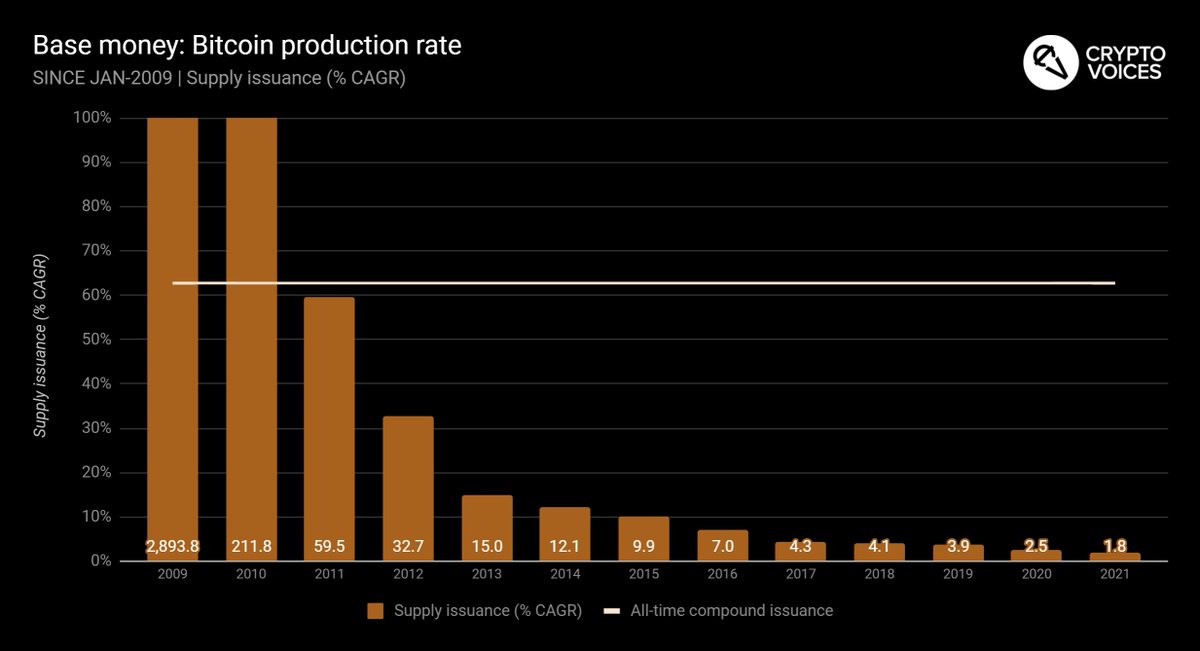
45/ Also notice the phrase "supply issuance" for Bitcoin's chart titles, and not "inflation." Bitcoin's "inflation," economically, is already baked in. Everyone knows its max supply. As already demonstrated, its growth rate is known until 2141, per the protocol.
46/ So when it comes to bitcoins, "inflation" is not the best term. "Coin issuance" is more apropos, as its overall supply is fixed & known. As monetary expert George Selgin said on our show, "We know it's 21 million, and that's that." This is uniquely unlike fiat, or even gold.
47/ One more thing on gold and silver. Bird's eye. Of all the "transparent," reported repositories of bullion (sourced from Nick Laird) - all ETFs, even Peter Schiff's GoldMoney, #Bitcoin has passed gold & silver in these vaults COMBINED. 

48/ Oh yes, and another reminder, last year #Bitcoin also passed the entire "available" (not lost to industry) supply of #silver value in the world.
49/ Alright. Now that we've seen all the data, let's finally take a quick look at some price chat, because even though I told you none of the above covers prices, I know you're thinking about how all of this monetary inflation has affected or will affect prices.
50/ Milton Friedman said, "Inflation is always and everywhere a monetary phenomenon." He meant price inflation (not graphed above) always and everywhere follows money inflation (very much graphed above).
51/ The rub is it is impossible to predict how and when price inflation will happen. Impossible to predict. Hyperinflations (of prices) or otherwise. The best we can do is measure the money supply and its growth, as we've done here.
52/ But we can say this: If the supply of base money increases, and if there is no or a lesser increase in the demand for that money, then ceteris paribus, prices will rise. Ceteris paribus, a growing base money supply will always undermine that money's purchasing power.
53/ These are some of the reasons why the market chose hard money like gold & silver. Always emergent in human action, unless there is monopoly intervention (fiat), the market will decide the best money. If aliens in a one-off whisked away our gold, we'd choose the next best...
54/ Let's take one more detour back to the dollar and the USA specifically, to see why it matters to track the growth of the monetary base (the *money*), versus the growth of other economic stuff. Focus on the green box first. Let's keep in mind the lessons we've learned…
55/ First, in the last 20 years the supply of basic money grew 12.1% per year, or doubled every 6 years. The Fed's mandate is to control inflation and keep people employed. GDP would be one way to measure economic health. How fast did it grow? Only 3.7% per year. 

56/ In 2000, $1 of basic money printed got you $17 of GDP. Now? $1 gets you only $3.61 in GDP. In 2000, 1% of unemployment would cost you $87 billion in printed dollars. Now? $546 billion for the same 1%. And... government debt grew 8.3% per year as well, doubling every 9 years.
57/ And continuing, we can start to see why measuring "price inflation" is hopeless. Gold valued in dollars? Grew 11.9% per year. Stocks? 7.7% per year. Bonds? Only 4.7% per year. Bonds (specifically the gov't variety) are return-free risk, not the colloquial opposite.
58/ A few notes before the final summary. Almost done! Remember these are the top 30 currencies in the world over the past 50 years. Zimbabwe & Belarus don't make the cut; as their monetary base is so tiny, their hyperinflations would barely move the needle on what's presented.
59/ For the euro, its accounting creation began in 1999, and it started circulating in 2002. Prior to 2002, we are building a blended monetary base for the euro back to 1970, and as of now, include 3 of the very largest: the Deutsch mark, the French franc, and the Italian lira.
60/ To be absolutely clear on the global fiat blended inflation rate: it's calculated using a weighted factor of each country's base money supply, based on how large their US$ equivalent actually is, during that month. This weight evolves as more currencies are added.
61/ As we look back in time, for those currencies that weren't established, they didn't factor into that period's global inflation. For example, the US dollar's weight itself was 40% of the pie in 1970, and only 21% today, as (among others), data on China begins only in Dec-1999.
62/ Regarding compound annual growth rates: they're always calculated from monthly fiat unit growth, then compounded to annual (to the 12th exponent). This is necessary due to cases like Brazil and Argentina, which had 6 and 4 different currencies respectively, since 1970 alone.
63/ Continuing, a compound annual growth rate from a 1970 currency to 2020 currency doesn't make sense for Brazil. So the *monthly* rate must be taken across time and then compounded, ignoring those 6 months when the central bank reset (slashed zeroes) from the old currency.
64/ Interesting note on Brazil. Though China is famously coming, Brazil is actually one of the first countries to have a proto-digital currency floating around, directly managed by CB. Called the PIX, established at end of 2020. Thx to @lucasrla for helping pinpoint the data.
65/ And finally, the mechanics of this method (compounding monthly growth rates to annual) were of course repeated across gold, silver, & bitcoin's supply curves, for consistency. The only exception is the TTM column in the summary (coming). There it's simple year-on-year growth.
66/ On our podcast @crypto_voices, we explore the varying economic nuances of #Bitcoin as a contender for the global monetary base, for global money, for the prospect of it achieving ultimate settlement status.
67/ To sum up, this graphic includes all items. Print it out if you like. The base money of 113 nations is reflected inside the top 30 currencies, and it summarizes gold, silver, and the supply of bitcoins. It is a supply-side summary of essentially all basic money in the world. 

68/ Head over to cryptovoices.com/basemoney or basemoney.world to learn more. Fiat base money is sourced from central bank balance sheets, wonderful gold and silver history from industry expert Nick Laird, and bitcoin from @coinmetrics.
69/ These penultimate graphics illustrate how Bitcoin's supply (US$ equivalent) compares across all other basic money, past and present. Bitcoin sits at 3%. Highest ever. The #RealBitcoinDominanceIndex. 



70/ And finally, let's show again what it takes for #Bitcoin to surpass the Big 4 currencies' monetary base value. Again with the definite caveat that these are calculations, not predictions… that chart is here. 

71/ More to come in the future. We are continuing to work on this topic. Any sats you might spare to contribute are very much appreciated, and will help keep up the research. Donations in $BTC may be made here: donations.cryptovoices.com
/fin
/fin
• • •
Missing some Tweet in this thread? You can try to
force a refresh


